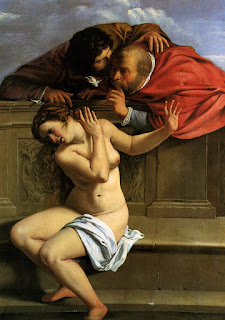Now, I am the first to admit that my knowledge of the Italian artist Artemisia Gentileschi was pretty much limited to the fact that she was a woman artist in a time dominated by men.
According to one source, Artemisia Gentileschi “was an Italian Baroque painter, now considered one of the most accomplished seventeenth-century artists, initially working in the style of Caravaggio.
In an era when women had few opportunities to pursue artistic training or work as professional artists, Artemisia was the first woman to become a member of the Accademia di Arte del Disegno in Florence and had an international clientele”.*
My real introduction came this morning from a piece on the wireless, where Germain Greer, discussed the life of the artist in advance of a major exhibition at the National Gallery, between October and January.
Even if we were not in the age of Covid, I doubt I would get down to London to see the paintings on show, so I will have to content myself with the her work which is displayed on the links below.
The notes from the National Gallery begin with Artemisia’s own bold declaration that "’I will show Your Illustrious Lordship what a woman can do’", and go on, “In 17th-century Europe, at a time when women artists were not easily accepted, Artemisia was exceptional.
She challenged conventions and defied expectations to become a successful artist and one of the greatest storytellers of her time.
Artemisia painted subjects that were traditionally the preserve of male artists and for the male gaze; transforming meek maidservants into courageous conspirators and victims into survivors.
In this first major exhibition of Artemisia’s work in the UK, see her best-known paintings including two versions of her iconic and viscerally violent ‘Judith beheading Holofernes’; as well as her self portraits, heroines from history and the Bible, and recently discovered personal letters, seen in the UK for the first time.
Follow in Artemisia’s footsteps from Rome to Florence, Venice, Naples and London. Hear her voice from her letters, and see the world through her eyes”.
So that is pretty much it, other than to say that at 17 she was raped by a man employed to teach her, but the court case brought by her father was not about the rape, but that the man in question had stolen a family painting.
And according to Ms Greer in the course of the interrogation into the alleged theft, Artemisia was tortured by the authorities, which was appalling enough, but made worse by the deliberate act of targeting her fingers which appears a callous and deliberate attack on her career as an artist.
So, there is much more to find out about the artist, and a heap of paintings to explore.
Location; National Gallery, London
Pictures, Self-Portrait as the Allegory of Painting, 1638-1639, Self portrait as a lute player, 1615-1617, Judith and her Maidservant, 1625, Susanna and the Elders, 1610, her first known work, Self-Portrait as Saint Catherine of Alexandria, c. 1616
* Artemisia Gentileschi, https://en.wikipedia.org/wiki/Artemisia_Gentileschi#:~:text=In%20an%20era%20when%20women%20had%20few%20opportunities,Disegno%20in%20Florence%20and%20had%20an%20international%20clientele.
** Artemisia, https://www.nationalgallery.org.uk/exhibitions/artemisia





No comments:
Post a Comment